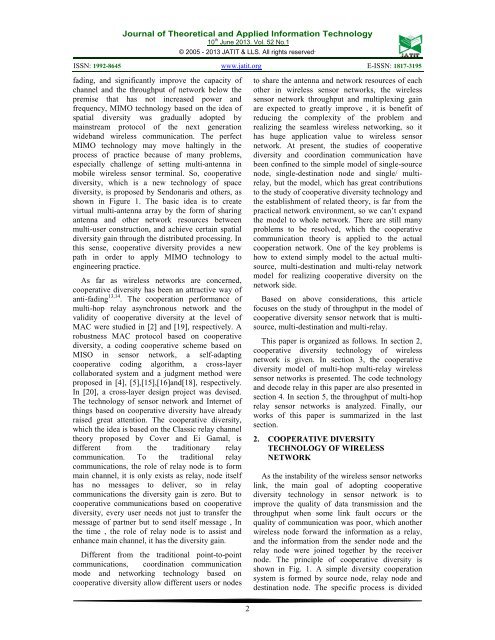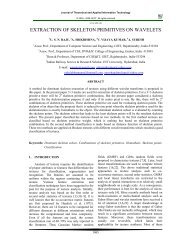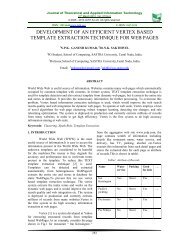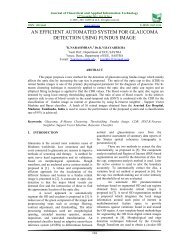Full Text - Journal of Theoretical and Applied Information Technology
Full Text - Journal of Theoretical and Applied Information Technology
Full Text - Journal of Theoretical and Applied Information Technology
Create successful ePaper yourself
Turn your PDF publications into a flip-book with our unique Google optimized e-Paper software.
<strong>Journal</strong> <strong>of</strong> <strong>Theoretical</strong> <strong>and</strong> <strong>Applied</strong> <strong>Information</strong> <strong>Technology</strong><br />
10 th June 2013. Vol. 52 No.1<br />
© 2005 - 2013 JATIT & LLS. All rights reserved .<br />
ISSN: 1992-8645 www.jatit.org E-ISSN: 1817-3195<br />
fading, <strong>and</strong> significantly improve the capacity <strong>of</strong><br />
channel <strong>and</strong> the throughput <strong>of</strong> network below the<br />
premise that has not increased power <strong>and</strong><br />
frequency, MIMO technology based on the idea <strong>of</strong><br />
spatial diversity was gradually adopted by<br />
mainstream protocol <strong>of</strong> the next generation<br />
wideb<strong>and</strong> wireless communication. The perfect<br />
MIMO technology may move haltingly in the<br />
process <strong>of</strong> practice because <strong>of</strong> many problems,<br />
especially challenge <strong>of</strong> setting multi-antenna in<br />
mobile wireless sensor terminal. So, cooperative<br />
diversity, which is a new technology <strong>of</strong> space<br />
diversity, is proposed by Sendonaris <strong>and</strong> others, as<br />
shown in Figure 1. The basic idea is to create<br />
virtual multi-antenna array by the form <strong>of</strong> sharing<br />
antenna <strong>and</strong> other network resources between<br />
multi-user construction, <strong>and</strong> achieve certain spatial<br />
diversity gain through the distributed processing. In<br />
this sense, cooperative diversity provides a new<br />
path in order to apply MIMO technology to<br />
engineering practice.<br />
As far as wireless networks are concerned,<br />
cooperative diversity has been an attractive way <strong>of</strong><br />
anti-fading 13,14 . The cooperation performance <strong>of</strong><br />
multi-hop relay asynchronous network <strong>and</strong> the<br />
validity <strong>of</strong> cooperative diversity at the level <strong>of</strong><br />
MAC were studied in [2] <strong>and</strong> [19], respectively. A<br />
robustness MAC protocol based on cooperative<br />
diversity, a coding cooperative scheme based on<br />
MISO in sensor network, a self-adapting<br />
cooperative coding algorithm, a cross-layer<br />
collaborated system <strong>and</strong> a judgment method were<br />
proposed in [4], [5],[15],[16]<strong>and</strong>[18], respectively.<br />
In [20], a cross-layer design project was devised.<br />
The technology <strong>of</strong> sensor network <strong>and</strong> Internet <strong>of</strong><br />
things based on cooperative diversity have already<br />
raised great attention. The cooperative diversity,<br />
which the idea is based on the Classic relay channel<br />
theory proposed by Cover <strong>and</strong> Ei Gamal, is<br />
different from the traditionary relay<br />
communication. To the traditional relay<br />
communications, the role <strong>of</strong> relay node is to form<br />
main channel, it is only exists as relay, node itself<br />
has no messages to deliver, so in relay<br />
communications the diversity gain is zero. But to<br />
cooperative communications based on cooperative<br />
diversity, every user needs not just to transfer the<br />
message <strong>of</strong> partner but to send itself message , In<br />
the time , the role <strong>of</strong> relay node is to assist <strong>and</strong><br />
enhance main channel, it has the diversity gain.<br />
Different from the traditional point-to-point<br />
communications, coordination communication<br />
mode <strong>and</strong> networking technology based on<br />
cooperative diversity allow different users or nodes<br />
to share the antenna <strong>and</strong> network resources <strong>of</strong> each<br />
other in wireless sensor networks, the wireless<br />
sensor network throughput <strong>and</strong> multiplexing gain<br />
are expected to greatly improve , it is benefit <strong>of</strong><br />
reducing the complexity <strong>of</strong> the problem <strong>and</strong><br />
realizing the seamless wireless networking, so it<br />
has huge application value to wireless sensor<br />
network. At present, the studies <strong>of</strong> cooperative<br />
diversity <strong>and</strong> coordination communication have<br />
been confined to the simple model <strong>of</strong> single-source<br />
node, single-destination node <strong>and</strong> single/ multirelay,<br />
but the model, which has great contributions<br />
to the study <strong>of</strong> cooperative diversity technology <strong>and</strong><br />
the establishment <strong>of</strong> related theory, is far from the<br />
practical network environment, so we can’t exp<strong>and</strong><br />
the model to whole network. There are still many<br />
problems to be resolved, which the cooperative<br />
communication theory is applied to the actual<br />
cooperation network. One <strong>of</strong> the key problems is<br />
how to extend simply model to the actual multisource,<br />
multi-destination <strong>and</strong> multi-relay network<br />
model for realizing cooperative diversity on the<br />
network side.<br />
Based on above considerations, this article<br />
focuses on the study <strong>of</strong> throughput in the model <strong>of</strong><br />
cooperative diversity sensor network that is multisource,<br />
multi-destination <strong>and</strong> multi-relay.<br />
This paper is organized as follows. In section 2,<br />
cooperative diversity technology <strong>of</strong> wireless<br />
network is given. In section 3, the cooperative<br />
diversity model <strong>of</strong> multi-hop multi-relay wireless<br />
sensor networks is presented. The code technology<br />
<strong>and</strong> decode relay in this paper are also presented in<br />
section 4. In section 5, the throughput <strong>of</strong> multi-hop<br />
relay sensor networks is analyzed. Finally, our<br />
works <strong>of</strong> this paper is summarized in the last<br />
section.<br />
2. COOPERATIVE DIVERSITY<br />
TECHNOLOGY OF WIRELESS<br />
NETWORK<br />
As the instability <strong>of</strong> the wireless sensor networks<br />
link, the main goal <strong>of</strong> adopting cooperative<br />
diversity technology in sensor network is to<br />
improve the quality <strong>of</strong> data transmission <strong>and</strong> the<br />
throughput when some link fault occurs or the<br />
quality <strong>of</strong> communication was poor, which another<br />
wireless node forward the information as a relay,<br />
<strong>and</strong> the information from the sender node <strong>and</strong> the<br />
relay node were joined together by the receiver<br />
node. The principle <strong>of</strong> cooperative diversity is<br />
shown in Fig. 1. A simple diversity cooperation<br />
system is formed by source node, relay node <strong>and</strong><br />
destination node. The specific process is divided<br />
2
















